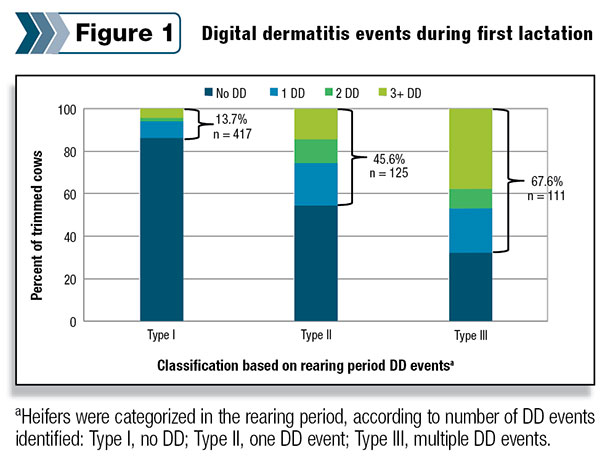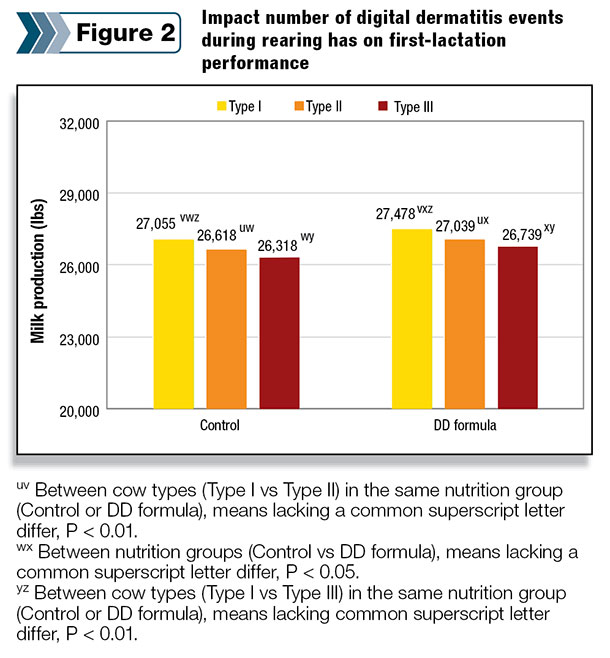Understanding the link between nutrition, healthy claws and production Inadequate nutrition during the rearing period may result in heifers of insufficient size at breeding, delayed ovulation, delayed first breeding and extended time to entrance into the lactating herd as a first-calf heifer.
These delays add tremendous costs to the rearing program. Researchers at Penn State University estimate that growth delays cost approximately $1.50 to $2 per heifer per day. Thus, each month of delayed breeding adds considerable cost to the value of replacement dairy heifers.
Raising dairy replacement heifers to an adequate size at first calving between 22 and 24 months old is an achievable goal, one that helps to optimize profitable milk production. Accomplishing this goal requires proper nutrition and feeding management so heifers are large enough to breed at 13 to 15 months old.
A properly balanced ration, including minerals and vitamins, provides the essential building blocks heifers need for physical development, healthy calving and higher lifetime milk production. Trace minerals are also essential in helping heifers build a more competent immune system and reproductive tract as well as improving skin and claw integrity, thus boosting an animal’s ability to resist disease and perform.
Research increasingly validates the link among nutrition, healthy claws and production. While this connection is well established in lactating cows, new research shows this connection also exists in replacement heifers.
Research by Arturo Gomez reveals that trace mineral nutrition, as well as prevention and control of digital dermatitis (DD) during the rearing period, are two key drivers impacting a heifer’s health and performance during first lactation. From milk production and reproduction to hoof health, it pays to invest in effectively managing nutrition and hoof health in replacement dairy heifers.
A closer look at the research
In this recent study, researchers investigated the impact DD events occurring between breeding and first calving had on first-lactation performance (health, reproduction, milk production). In addition, they evaluated the impact trace mineral source had on first-lactation performance, independent of DD occurrence.
Six months prior to calving, a total of 719 pregnant heifers were enrolled in the study. All heifers were fed the same base TMR with either metal amino acid complexes or inorganic trace minerals (included in “control” treatment). Immediately before calving, all heifers were classified as Type I, II or III based on the number of active DD lesions (greater than 0.75 inches or 2 cm in diameter; M2) identified during the rearing period: Type I, no DD event; Type II, one DD event; or Type III, multiple DD events.
Fresh cow health during the initial 60 days in milk, reproduction, hoof health and milk production during first lactation were compared among the three different heifer types.
Overall, results from the study reveal that heifers experiencing DD during the rearing period showed decreased milk production, reproduction and hoof health during their first lactation compared to heifers not experiencing DD during rearing. Source of trace minerals fed during rearing also had an impact on first-lactation milk production.
Impact on hoof health
Heifers with one DD event or multiple DD events between breeding and first calving were at greater risk (45.6 percent and 67.6 percent versus 13.7 percent) for DD incidence during first lactation compared to heifers that experienced no DD (Figure 1) during rearing. It’s important to note that heifers with multiple DD events between breeding and first calving also experienced DD earlier post-calving.
Impact on reproduction
Interestingly, replacement heifers with multiple DD events during rearing had decreased first conception rates (29 percent versus 42 percent) and increased number of days open (157 versus 132) compared to heifers that experienced no DD prior to calving.
Impact on lactation performance
First-calf heifers produced significantly less 305-day milk yield when they experienced either one DD event or multiple DD events between breeding and first calving (439 pounds and 738 pounds milk loss, respectively; Figure 2), compared to heifers with no DD.
 These differences resulted from a greater decline in rate of milk production after peak yield (poorer persistency). Additionally, independent of DD occurrence, heifers consuming trace minerals as metal amino acid complexes during the rearing period produced 423 pounds more 305-day milk yield than heifers fed ordinary inorganic trace minerals.
These differences resulted from a greater decline in rate of milk production after peak yield (poorer persistency). Additionally, independent of DD occurrence, heifers consuming trace minerals as metal amino acid complexes during the rearing period produced 423 pounds more 305-day milk yield than heifers fed ordinary inorganic trace minerals.
By improving nutrition and management during the rearing period, producers can reap the rewards of improved milk production, reproduction and hoof health once heifers enter their first lactation.
This recent research reinforces a strategy of successful DD prevention and control programs (including management, hygiene and nutrition) in replacement heifers – with the objective of reducing recurrence rates for DD during the first lactation.
DD prevention and control
As we learn more about how DD infects and spreads through a herd, it becomes clear that a disease prevention and control strategy will be successful when started early in an animal’s life. Effective prevention and control strategies include three key components:
1. Management – Implement biosecurity measures to prevent infected animals from being introduced into the herd, regularly inspect hind feet, keep records of lesions on animals for informed decision-making based on animal and disease history, and identify M2 lesions (greater than 0.75 inches or 2 cm in diameter).
2. Hygiene – Promote a clean, dry environment and use footbaths (as needed).
3. Nutrition – Increase awareness of nutrition’s role in helping to prevent DD during all growth phases, including heifers and youngstock; formulate diets for adequate nutrient and micronutrient fortification.








